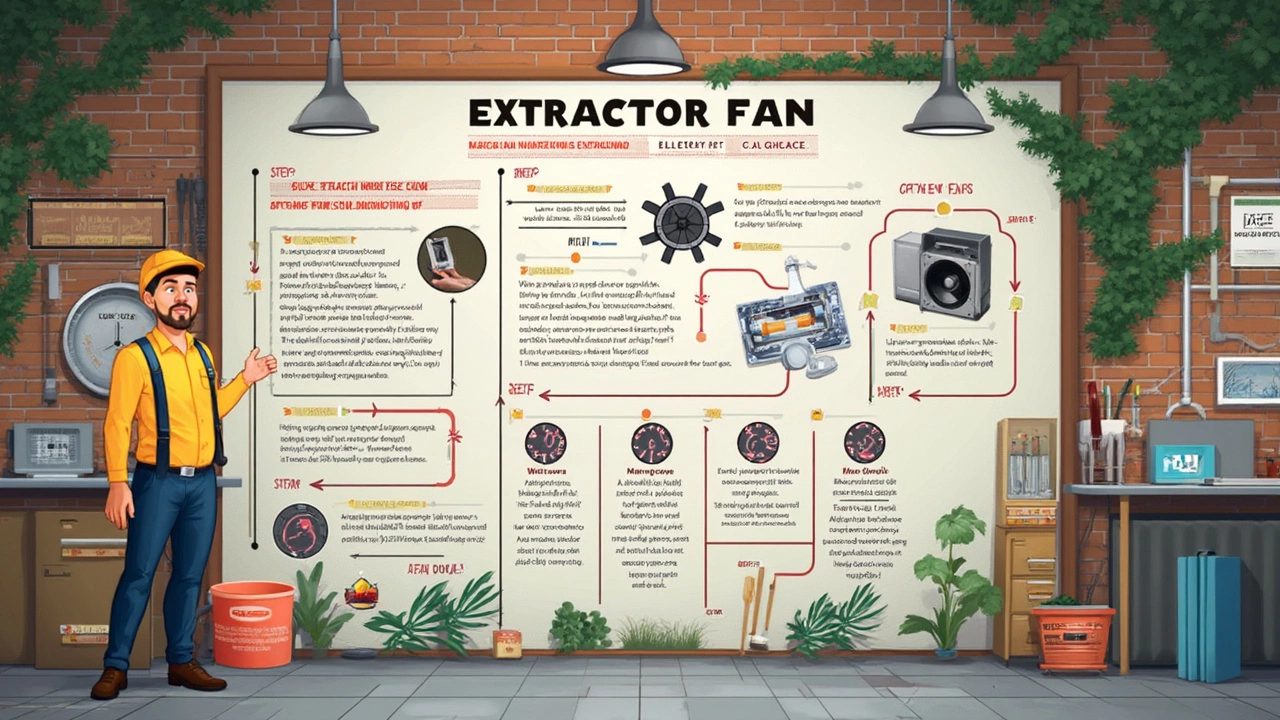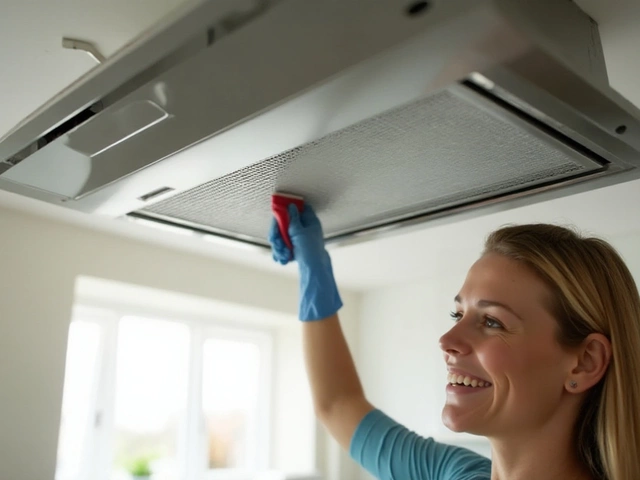So, you've got an extractor fan that's acting up, and you're wondering who to call. Are electricians the right folks for the job? Well, the short answer is: yes, they can be. But let's break it down a bit more.
Electricians deal with all things electrical—wiring, circuit troubleshooting, and yes, fixing electrical appliances like your trusty extractor fan. These fans can run into issues like faulty wiring, burned-out motors, or jammed fan blades. It makes sense, right? If electricity is involved, the sparkies are your go-to people.
But before you shell out for a service call, there are a few things you can check yourself. Is the fan plugged in properly? Is there a buildup of lint or grease? A good clean might sort things out without needing to call a pro. But if the problem's more serious—a weird noise or odd smell—then it’s definitely time to bring in an expert.
- What Do Electricians Do?
- Common Extractor Fan Issues
- How Electricians Fix Them
- DIY Maintenance Tips
- When to Consider Replacing
What Do Electricians Do?
Electricians are your professional problem-solvers when it comes to all things electrical. They handle the wiring, repair, and maintenance of electrical systems in homes, offices, and other buildings. Whether it's getting your lights back on or ensuring your sockets are safe, they’re the folks you'd call.
Electricians are trained and licensed to handle these tasks safely, which is super important because, well, electricity isn't something to mess around with. They diagnose issues, plan and install electrical wiring, and even deal with complex systems that involve power distribution and control setups.
Typical Tasks Electricians Handle
- Electrical Installations: Setting up new wiring, outlets, and electrical appliances.
- Maintenance Checks: Regularly inspecting electrical components for wear and tear.
- Troubleshooting: Diagnosing and repairing faults in electrical systems.
- Safety Compliance: Ensuring all electrical work meets the required safety standards and regulations.
For an extractor fan repair, electricians can assess the wiring and motor functionality, which are often the culprits behind a malfunctioning fan. They’ll ensure that everything is up to par with current electrical codes, giving you peace of mind and a breath of fresh air—literally!
Common Extractor Fan Issues
Extractor fans are like the unsung heroes of our kitchens and bathrooms, whisking away smells and moisture. But they do run into trouble now and then. Let’s take a look at some typical extractor fan repair issues.
1. Motor Malfunctions
If your fan is making odd noises or has stopped working altogether, chances are the motor's to blame. Motors can burn out over time, especially if they're overworked or clogged with dirt. An electrician can replace a faulty motor, getting your fan back in action.
2. Wiring Problems
Wiring can be finicky, and any faults may lead to power failures. If you've noticed the fan isn’t turning on and off properly, or there's intermittent functionality, you might have a wiring issue. A skilled electrician can diagnose and fix these problems safely.
3. Blocked Fans
Fans need to breathe. Over time, dust, grease, and lint can clog up the works. Blocked fans struggle to do their job and might overheat. Regular cleaning can help, but if the blockage is deep or complex, you might need professional cleaning or part replacement.
4. Strange Noises
Banging, buzzing, or rattling noises are not normal. They can be due to loose parts, worn-out components, or foreign objects caught in the fan. An expert can take a look, identify the noise source, and decide whether repair or replacement is necessary.
5. Age and Wear
Like most techy things, all exhaust systems have a lifespan. Older fans may simply wear out. If repairs start piling up, talk to an electrician about whether a new extractor fan might save you money and hassle in the long run.
Check out this small table that gives a quick look at common issues and potential fixes:
| Issue | Possible Fix |
|---|---|
| Motor Problems | Replace motor |
| Wiring Faults | Repair or replace wiring |
| Blocked Fans | Clean or unclog |
| Weird Sounds | Tighten, repair, or remove obstructions |
| General Wear | Consider replacing the fan |

How Electricians Fix Them
When you call in an electrician to fix an extractor fan, they're pretty much like detectives on a mission. They start by diagnosing the problem, which sometimes means taking a closer look at things that might not be obvious at first.
Inspecting Electrical Connections
First off, they'll check the electrical connections. Faulty wiring or loose connections can often be the culprit behind an extractor fan refusing to work. With their tools, electricians test the wires and connections using a multimeter to ensure the current is flowing correctly.
Motor Checks
If everything looks good at the electrical end, they’ll move on to the motor. The motor is the heart of your fan, and if it’s burned-out or overworked, it'll need some TLC. Electricians will either clean or replace the motor, depending on the state it's in. Replacing a motor is no small feat, so it’s definitely something you want handled by a professional.
Fan Blades and Housing
Sometimes, the issue isn’t electrical at all. If the fan blades are jammed or if there’s debris stuck in the housing, it can cause the fan to screech to a halt. Electricians will clean out any gunk or buildup, ensuring the blades can spin freely. A good scrub might just be what your fan needs.
- Check wiring and connections
- Test and possibly replace the motor
- Clear debris and clean fan blades
These aren't exhaustive steps, but they cover a lot of ground in troubleshooting. Electricians have the expertise to figure out whether it's time for a repair or a replacement. So, before you think about buying a new fan, it's good to give these pros a chance to work their magic.
DIY Maintenance Tips
Keeping your extractor fan in tip-top shape doesn't always need a pro's touch. Regular maintenance can save you a headache down the line by preventing common issues. So let's get our hands a little dirty, shall we?
Regular Cleaning
A clean fan is a happy fan. Dust and grease buildup is a top culprit in fan failures, especially in kitchens. To keep your fan efficiently blowing away stale air, clean it every three to six months. Start by removing the cover; most pop off easily, but some may need a screwdriver.
- Soak the cover in warm, soapy water to dissolve any grease.
- Use a soft brush to remove dust from the blades. Avoid getting the motor wet!
- Dry everything thoroughly before reassembling.
Checking Electrical Connections
Loose wiring can cause your extractor fan to misbehave or stop working altogether. Safety first, though—cut power to the fan at the circuit breaker before poking around.
Once you're sure the power's off, remove the fan's cover and inspect the connections. Tighten any loose screws holding wires in place. Reattach the cover, restore power, and see if that solved your issue.
Lubricate Moving Parts
Over time, moving parts can get a bit sluggish. A bit of lubrication on the fan's motor shaft can keep everything running smoothly. Use a light machine oil—just a couple of drops will do.
"A little maintenance goes a long way. Regular care and attention can extend the life of your extractor fan significantly," says John Humphries, an experienced electrician and author on home repairs.
By taking these simple steps, you'll not only prolong the life of your extractor fan but also keep your home's air quality top-notch.
| Maintenance Task | Frequency |
|---|---|
| Cleaning | Every 3-6 months |
| Electrical Check | Annually |
| Lubrication | Annually |

When to Consider Replacing
Alright, so you've tried fixing your extractor fan but it's still giving you grief. When should you consider replacing it altogether?
Signs Your Extractor Fan Might Be on Its Last Legs
Sometimes, repair just won't cut it. Here's when you should think about getting a new one:
- Age: If your fan is over 10 years old, it might simply be time. Technology advances and older models can't keep up with modern standards for efficiency and noise levels.
- Frequent Breakdowns: If you find yourself calling the electrician every other month, replacement could be more cost-effective in the long run.
- Inefficient Performance: If it's not clearing odors or smoke effectively anymore, that’s a big sign it needs replacing.
John Mackenzie, a well-known electrical engineer, says,
"While small repairs are feasible, a fan that's struggling persistently will end up causing headaches both in terms of cost and effectiveness. Consider upgrading to stay ahead."
New Features Worth Considering
So, if you're headed out to get a new fan, what should you look for?
- Energy Efficiency: Look for models with high energy efficiency ratings to cut down on electricity bills.
- Noise Levels: Some new models operate almost silently, a huge plus if your fan is in a frequently occupied space.
- Smart Features: Newfangled gadgets can include sensors that automatically turn the fan on or off based on air quality, saving further on energy costs.
Still sitting on the fence about it? Try asking around or checking out online reviews. They'll give you a sense of what new models are worth the investment. Remember, if all else fails, chatting with a seasoned electrician can provide personalized advice tailored to your situation.




